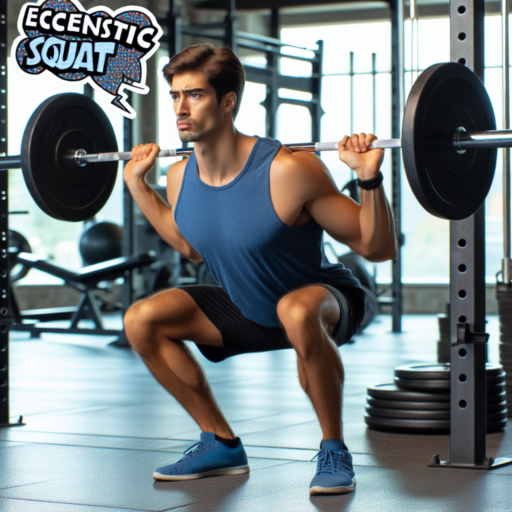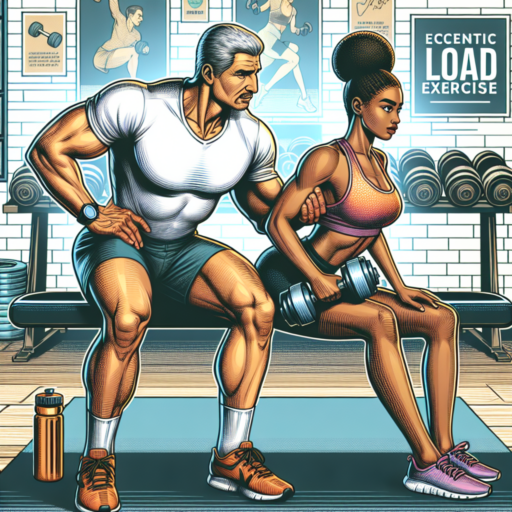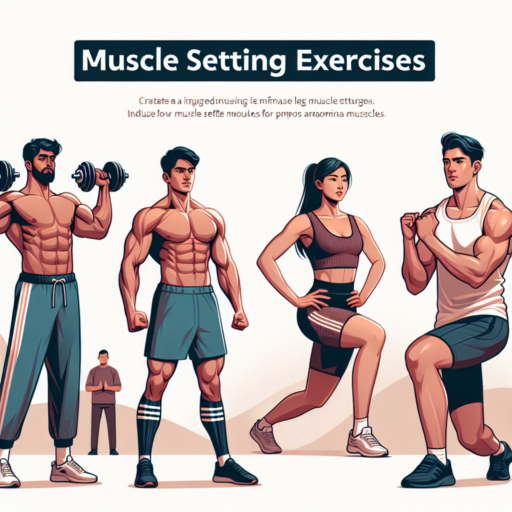Introduction to Eccentric Squat Exercise
The Eccentric Squat Exercise, often overlooked, is a powerful component of strength training that emphasizes the lowering phase of the squat. Unlike conventional squats that focus on both the descending and ascending actions equally, the eccentric squat zeroes in on the muscle lengthening process, which can lead to significant gains in strength, muscle mass, and flexibility. This introduction aims to shed light on the distinctive aspects and benefits of incorporating eccentric squats into your fitness routine.
Adding eccentric squats to your workout regimen involves focusing on the slow and controlled downward motion of the squat, resisting gravity as you lower your body. This method not only challenges your muscles in a unique way but also increases mind-muscle connection and control. By prioritizing the eccentric phase, athletes can experience a reduced risk of injury and improved athletic performance, making it a valuable exercise for both beginners and advanced fitness enthusiasts.
The technique behind eccentric squats differentiates significantly from traditional squats. By extending the duration of the lowering phase—often to three to five seconds or longer—this exercise places additional stress on the muscle fibers, leading to greater adaptations in muscle strength and size. Furthermore, the increased time under tension can enhance joint mobility and stability, particularly in the knees and hips, which are crucial for executing a wide range of movements both in daily activities and in athletic performances.
Benefits of Eccentric Squats for Strength and Stability
Eccentric squats, an intensively effective variation of traditional squats, are recognized for their distinctive approach to enhancing muscle strength and overall stability. Unlike conventional squats that emphasize the upward movement, eccentric squats focus on the slow and controlled downward phase. This unique technique offers a plethora of benefits, making it a valuable addition to any fitness regimen.
First and foremost, eccentric squats significantly contribute to increased muscle hypertrophy. The prolonged tension during the downward movement intensifies the stress on the muscles, leading to greater muscle tear and, subsequently, repair. This process is critical for muscle growth and strength enhancement. Moreover, eccentric squats have been shown to improve the eccentric strength in athletes, which is essential for various physical activities, including running and jumping.
Additionally, the slow and controlled motion required for eccentric squats not only minimizes the risk of injury but also contributes to enhanced stability and balance. By engaging the core and lower body muscles more effectively, practitioners can expect improved proprioception. This is particularly beneficial for individuals looking to enhance their performance in sports or seeking to reduce the risk of falls in everyday activities.
Step-by-Step Guide to Performing Eccentric Squats Correctly
Eccentric squats, a variation of the traditional squat, focus primarily on the lowering phase of the movement. This slow and controlled descent phase can significantly enhance muscle strength and size, making it a valuable addition to any workout routine. Mastering the correct technique is crucial for maximizing benefits and minimizing injury risks. Follow this step-by-step guide to ensure you’re performing eccentric squats correctly.
Start with the Correct Stance
Begin your eccentric squat by standing with your feet shoulder-width apart or slightly wider. Your toes should be pointing slightly outward. Establish a strong, stable base by engaging your core, keeping your chest up and your back straight. This initial position is vital for maintaining balance and ensuring the focus remains on the targeted muscle groups throughout the exercise.
Initiate the Descent Slowly
Start the squat by pushing your hips back, as if you’re trying to sit in a chair that’s slightly too far behind you. Bend your knees and lower your body in a controlled manner. Unlike in traditional squats, where the emphasis is on both the lowering and lifting phases, eccentric squats require you to focus on a slow, three to five-second descent. Ensure your knees stay aligned with your toes and do not extend past your toes to avoid unnecessary strain on your knees.
Maintain Control and Posture Throughout
As you lower into the squat, maintain a strong core and flat back to support your spine. Keep lowering yourself until your thighs are at least parallel to the ground, though you can go deeper for a greater challenge if your mobility allows. It’s crucial during this phase to focus on control rather than speed. The power of eccentric squats comes from the tension maintained in your muscles during the slow descent, not from the speed of the movement.
Eccentric Squat Variations to Enhance Your Workout Routine
Incorporating eccentric squat variations into your training routine is a dynamic way to amplify muscle growth, increase strength, and enhance overall athletic performance. This method focuses on the lowering phase of the squat, where muscles lengthen under tension, providing a unique stimulus compared to traditional squats. By integrating these variations into your workout, you engage in a comprehensive approach to strength training that targets muscle fibers more effectively for superior results.
Among the numerous variations available, a few stand out for their efficacy and ability to challenge the body in new and beneficial ways. The Slow Descent Squat, for instance, emphasizes taking three to five seconds to lower into the squat position before a quick ascent. This tempo manipulation dramatically increases time under tension, a crucial factor for muscle hypertrophy. Similarly, the Paused Squat involves holding the bottom position for a specific period before rising, which improves muscle endurance and control.
Implementing these eccentric squat variations requires attention to form and a progressive approach to avoid overloading the muscles too quickly. Starting with lighter weights or even body weight allows practitioners to focus on the eccentric phase’s quality over quantity, gradually increasing intensity as technique and strength improve. This methodical approach ensures the muscles are adequately challenged while minimizing the risk of injury, making eccentric squats a valuable addition to any fitness regime.
Common Mistakes to Avoid in Eccentric Squat Exercise
When performing eccentric squats, a specific focus on the lowering phase of the squat is crucial for maximizing strength and muscle gains while minimizing the risk of injury. However, even the most diligent athletes can fall prey to certain pitfalls that compromise the effectiveness of their workouts. Recognizing and correcting these mistakes is key to ensuring that your eccentric squat routine delivers optimal results.
Ignoring Proper Form
One of the most common errors is neglecting proper form. This includes failing to maintain a neutral spine, allowing the knees to cave in, and not engaging the core throughout the movement. Such oversights not only reduce the efficacy of the exercise but significantly increase the risk of injury. Practitioners should focus on maintaining a controlled descent, keeping the weight on their heels, and ensuring that their knees track over their toes to fully harness the benefits of eccentric squats.
Rushing Through the Movement
Another mistake to avoid is rushing through the eccentric phase. The essence of eccentric squats is in the slow, controlled lowering of the body, which amplifies the tension on the muscles. Hurrying back to the starting position diminishes the time under tension—a key factor in muscle growth and strengthening. Aim for a descent that lasts at least 3-5 seconds to maximize muscle engagement and control.
By being mindful of these common pitfalls and focusing on proper technique, athletes can significantly enhance the effectiveness of their eccentric squat exercises. Avoiding these mistakes ensures a safer workout session and paves the way for more significant gains in strength and muscle development.
How Eccentric Squats Improve Injury Rehabilitation
Eccentric squats, a variation of traditional squats focused on the lowering phase of the exercise, play a crucial role in injury rehabilitation. This method emphasizes the deceleration of the squat movement, where muscles lengthen under tension, offering unique benefits for healing and strengthening. Understanding the mechanisms behind eccentric squats can shed light on why physical therapists often incorporate them into rehab programs.
Eccentric squats target muscle groups more intensely than concentric (muscle shortening) movements, leading to significant improvements in muscle strength and flexibility. Such enhancements are vital in the recovery process, especially for athletes or individuals recovering from leg, knee, or lower back injuries. The controlled motion helps in managing and distributing load across the muscle, reducing the risk of re-injury by conditioning the body to better absorb impacts.
Moreover, these squats are pivotal in correcting muscle imbalances, a common issue during rehabilitation. As the injured party works through the eccentric phase, they engage both the primary and stabilizing muscles, promoting symmetry and balance. This aspect is crucial for not only expediting recovery but also for preventing future injuries. By incorporating eccentric squats into a rehabilitation regimen, individuals can expect a holistic approach to healing, strengthening, and injury prevention.
Incorporating Eccentric Squats into Your Strength Training Program
Integrating eccentric squats into your strength training regimen can unlock several benefits and push your fitness journey to new heights. Unlike traditional squats, the emphasis in eccentric squats is on the lowering phase, or the eccentric phase, where the muscle lengthens. This technique not only enhances muscle hypertrophy but also significantly improves strength and stability. When performed correctly, eccentric squats can lead to better muscle control and increased overall performance in both athletic endeavors and daily activities.
Starting with eccentric squats requires a focus on the form to maximize benefits and minimize the risk of injury. Beginners should particularly pay attention to the speed at which they lower themselves, ensuring a slow and controlled descent. This methodical approach engages more muscle fibers, particularly in the glutes and hamstrings, and provides a solid foundation for improved strength. Incorporating these squats into your routine doesn’t require a complete overhaul; rather, beginning with one to two sets can be a great way to introduce this potent exercise into your regimen.
For those wondering about the optimal frequency and integration tactics, starting with once or twice a week can offer substantial benefits. It allows the body ample recovery time, which is crucial when dealing with the increased muscle tension that eccentric squats generate. Progression is key. As your body adapts, increasing the volume and intensity will help sustain muscle growth and strength improvements. Combining eccentric squats with other forms of training can further enhance muscle engagement and functional strength, making it a versatile addition to any workout plan.
No se han encontrado productos.
Frequently Asked Questions About Eccentric Squat Exercise
When it comes to strengthening the lower body, eccentric squat exercises have become increasingly popular among fitness enthusiasts and athletes. This unique approach focuses heavily on the lowering phase of the squat, intensifying the workout and targeting muscle groups more precisely. In this section, we delve into the most commonly asked questions surrounding this effective exercise variation.
What Makes Eccentric Squats Different?
Eccentric squats distinguish themselves by emphasizing the downward, or eccentric, phase of the squat. Instead of concentrating on lifting or standing up quickly, the performer slows down the descent, usually over a count of 3-5 seconds. This method not only increases muscle tension but also significantly improves strength and muscle hypertrophy over time.
Who Should Incorporate Eccentric Squats into Their Routine?
Though eccentric squats are beneficial for a wide range of individuals, they are particularly advantageous for those looking to enhance muscle strength, endurance, and control. Athletes aiming to improve their performance, individuals recovering from injury, or anyone seeking to add diversity to their routine can greatly benefit from the inclusion of eccentric squats. It’s essential, however, to start with basic squat mechanics and gradually progress to prevent injury.
Are There Any Risks Associated with Eccentric Squats?
Like any exercise, eccentric squats come with their own set of risks, especially if performed with improper form or without adequate preparation. The increased load on the muscles and joints during the eccentric phase can lead to strain if not executed correctly. Therefore, it is crucial to focus on proper technique and consult a fitness professional if you’re new to this exercise. Incorporating a balanced workout and allowing sufficient recovery time are also key to minimizing risks.




